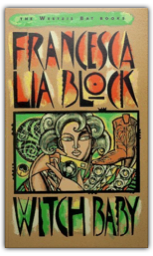
One of kids' favorite characters in Francesca Lia Block's Weetzie Bat series is Witch Baby: a tangly haired, purple-eyed girl who can curl her toes into cashew shapes. She's a bit of an outsider, more in touch with feelings and portents than the rest of the gang from Shangri-L.A. In Witch Baby and Missing Angel Juan, we're able to watch Witch Baby work through some of her feelings of alienation. Her willingness to explore darker emotional realms is a real inspiration, and, in fact, she seems more evolved and "whole" than the others. In Missing Angel Juan, Witch Baby finally finds a way to create her own sense of belonging. She finds out more about her history and her unique needs to push through some of the shyness and moodiness that has always kept her separate from others. 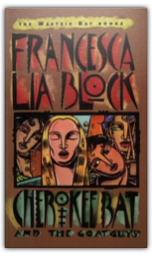
Once there was a slink-chunk, 
One of kids' favorite characters in Francesca Lia Block's Weetzie Bat series is Witch Baby: a tangly haired, purple-eyed girl who can curl her toes into cashew shapes. She's a bit of an outsider, more in touch with feelings and portents than the rest of the gang from Shangri-L.A. In Witch Baby and Missing Angel Juan, we're able to watch Witch Baby work through some of her feelings of alienation. Her willingness to explore darker emotional realms is a real inspiration, and, in fact, she seems more evolved and "whole" than the others. In Missing Angel Juan, Witch Baby finally finds a way to create her own sense of belonging. She finds out more about her history and her unique needs to push through some of the shyness and moodiness that has always kept her separate from others. 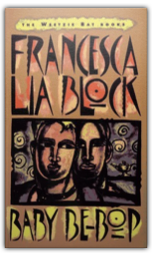
Everyone has a story to tell ... 
One of kids' favorite characters in Francesca Lia Block's Weetzie Bat series is Witch Baby: a tangly haired, purple-eyed girl who can curl her toes into cashew shapes. She's a bit of an outsider, more in touch with feelings and portents than the rest of the gang from Shangri-L.A. In Witch Baby and Missing Angel Juan, we're able to watch Witch Baby work through some of her feelings of alienation. Her willingness to explore darker emotional realms is a real inspiration, and, in fact, she seems more evolved and "whole" than the others. In Missing Angel Juan, Witch Baby finally finds a way to create her own sense of belonging. She finds out more about her history and her unique needs to push through some of the shyness and moodiness that has always kept her separate from others. 
Are you hip to the zine scene? Whether your answer is "absolutely!" "sort of," or "what's a zine?" everyone can learn from and be inspired by the funky, funny, fertile ideas set forth in Zine Scene. Written by Francesca Lia Block, author of the Weetzie Bat books (collected in Dangerous Angels), and Hillary Carlip, author of Girl Power: Young Women Speak Out, Zine Scene is both a tribute and a how-to guide to zines. Zines (as in magazines), are a righteous, radical form of creative self-expression. There are no hard-and-fast standards for zines, but they may contain one or more of the following: newsletters, journals, comic strips, artwork, photography, collage, poetry, and/or scrapbooks. The sky's the limit when it comes to production and length—from three pages of glossy paper to 30 pages of grainy photocopies. Block and Carlip teach by example, providing a plethora of reprints and excerpts from the tremendously diverse sea of zines. The range of zine creators, or "zinesters," is evident in the strong personalities that leap off the pages: the 21-year-old author of "Velvet Grass," who teaches her readers how to make arts and crafts (like duct tape shoes); "Flaming Jewboy," a 26-year-old drag queen whose manifesto includes "Thou Shalt Wear Heels"; the 17-year-old creator of "Private Catholic," who vents her feelings about private school; and 16-year-old Seth, master of several zines in which he discusses whatever he feels like—including his obsession with chicken fingers. 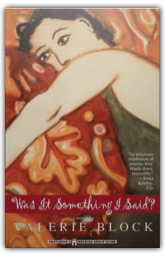
When Justine and Barry meet during a plane crash just before the Christmas holidays, the relationship that follows is wild, turbulent, and maybe, just maybe, a keeper. |
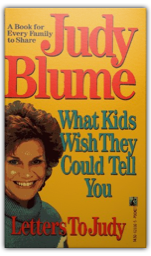
Judy Blume is the phenomenal author who has more than 35 million copies of her paperbacks in print. She has achieved multimillion-copy sales with her adult novels—Smart Women and Wifey—as well as her young adult novel Forever and fourteen children's titles. In Letters to Judy, she answers the questions and worries that concern parents and kids most. HC: Putnam. (Nonfiction) 
Leaping Poetry is Robert Bly's testament to the importance of the artistic leap that bridges the gap between conscious and unconscious thought in any great work of art. Part anthology and part commentary, Bly seeks to rejuvenate modern Western poetry through his revelations of “leaping” as found in the works of poets from around the world, while also outlining the basic principles that shape his own poetry. 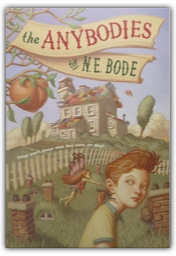
"Potter–style magic meets Snicket–y irreverence." – People Magazine 
There is a city beneath New York City, one made by and for Anybodies. There you can find Bing Chubb's Ballpark, Willy Fattler's ever–changing Underground Hotel, and a castle whose spire sticks up into the dirt–filled sky...dangerously close to the rear ends of unsuspecting picnic–goers in Central Park. It's an extraordinary place, but it is in danger of becoming ordinary because of the nefarious Blue Queen. Somebody has to stop her, and if anybody is going to, nobody is better than everybody's favorite Anybody. In her third quirky adventure, Fern takes on the biggest, baddest, bluest opponent ever. Yikes! 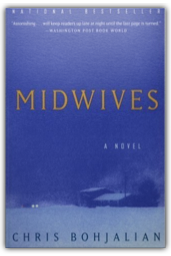
Oprah Book Club® Selection, October 1998: On a violent, stormy winter night, a home birth goes disastrously wrong. The phone lines are down, the roads slick with ice. The midwife, unable to get her patient to a hospital, works frantically to save both mother and child while her inexperienced assistant and the woman's terrified husband look on. The mother dies but the baby is saved thanks to an emergency C-section. And then the nightmare begins: the assistant suggests that maybe the woman wasn't really dead when the midwife operated:Did she perform at least eight or nine cycles as my mother said, or four or five as Asa recalled? That is the sort of detail that was disputable. But at some point within minutes of what my mother believed had been a stroke, after my mother concluded the cardiopulmonary resuscitation had failed to generate a pulse or a breath, she screamed for Asa and Anne to find her the sharpest knife in the house. In Midwives, Chris Bohjalian chronicles the events leading up to the trial of Sibyl Danforth, a respected midwife in the small Vermont town of Reddington, on charges of manslaughter. It quickly becomes evident, however, that Sibyl is not the only one on trial—the prosecuting attorney and the state's medical community are all anxious to use this tragedy as ammunition against midwifery in general; this particular midwife, after all, an ex-hippie who still evokes the best of the flower-power generation, is something of an anachronism in 1981. Through it all, Sibyl, her husband, Rand, and their teenage daughter, Connie, attempt to keep their family intact, but the stress of the trial—and Sibyl's growing closeness to her lawyer—puts pressure on both marriage and family. Bohjalian takes readers through the intricacies of childbirth and the law, and by the end of Sibyl Danforth's trial, it's difficult to decide which was more harrowing—the tragic delivery or its legal aftermath. 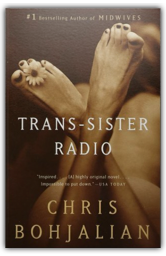
This sympathetic novel about the effect of a sex change on a romantic relationship, a family, and a community could almost be sold as a textbook—a kind of transgender Guide to the Perplexed. With its calming tone and scrupulous sensitivity to the feelings of all involved, it sometimes reads like a textbook, too. But while nobody is likely to launch a protest campaign over the cautious revelations of Trans-sister Radio, that's precisely the subject of Chris Bohjalian's seventh novel, in which a male college professor in a small Vermont town transforms himself into a woman. Even Dana Stevens's initial step in this direction—donning women's clothing—elicits a powerful reaction from the community. |

My Library
Collection Total:
1390 Items
1390 Items
Last Updated:
Mar 22, 2009
Mar 22, 2009


 Made with Delicious Library
Made with Delicious Library